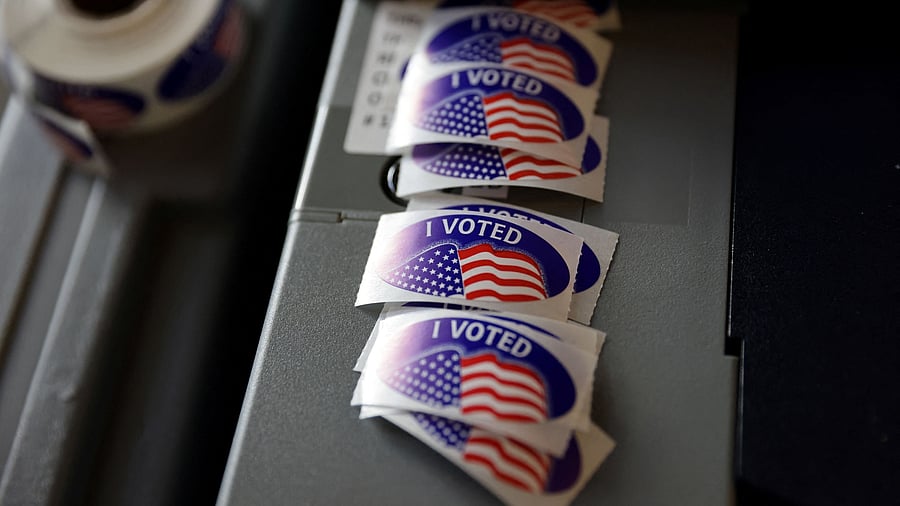
'I voted' stickers at a polling station during the 2024 US presidential election on Election Day.
Credit: Reuters Photo
In light of the transfer of power in the United States, it is interesting to reflect on the multi-party system in that country. Despite George Washington’s premonition that “the spirit of party serves always to distract the public councils and enfeeble the public administration” (Farewell Address, 1796), political parties are deeply embedded in the US political system.
The two dominant parties – Democratic and Republican – have shaped American politics since the mid-19th century to the extent that the system is considered ‘two-party dominant’. Other political parties such as the Green Party, Libertarian Party, Communist Party, Independent Party, Reform Party, and Constitution Party are relegated to the status of “third parties”. How many, for instance, know Jill Stein, the Green Party’s nominee in the 2012, 2016, and 2024 presidential elections?
The roots of political parties in the US can be traced to early disagreements over crucial issues confronting the new republic: loyalty to Britain (Loyalists vs Patriots), the strength of federal government (Federalists vs Anti-Federalists), economic development models (agricultural or commercial), or the establishment of a national bank (Hamiltonians vs Jeffersonians).
These disagreements among key personalities gradually evolved into factions and, eventually, into the establishment of full-fledged political parties with their own ideological positions. Initially dominated by elites, parties later expanded their reach to the grassroots. The current two-party system crystallised during the Antebellum period and solidified after the Civil War.
The electoral system—the winner-takes-all plurality system—further strengthened the two-party system, confirming Duverger’s Law, which states that “the simple majority, single ballot system favours the two-party system”. Additional factors, such as restrictions on ballot access, election funding rules, and stringent nomination requirements, have further consolidated the two-party system.
Founded in 1828, the Democratic Party is represented by the symbol of a donkey and the colour blue. The Republican Party, founded in 1854, is represented by an elephant and the colour red. Throughout most of US political history, these two parties have alternated control of the presidency and Congress.
Republicans are ideologically conservative, aligning with business and religious interests, while Democrats, often described as a “big tent” party, advocate for an array of groups like workers, women, the coloured, Hispanics, and environmentalists.
Interestingly, both parties take positions on issues that matter to most Americans, including unemployment, taxation, civil rights, social security, immigration, abortion, gun control, crime, healthcare, and climate change. Democrats favour demand-side economic policies, while Republicans advocate supply-side approaches. Both parties switched roles on civil rights advocacy at various times for political reasons. The ‘Solid South’ of the Democrats turned into a stronghold of the Republicans due to the latter’s ‘Southern Strategy’.
Compared to Democrats, Republicans lay more emphasis on national security and strict immigration procedures. Although there are exceptions, Democrats tend to favour abortions, but Republicans tend to be “pro-life”. On gun control, Democrats want more regulations, but Republicans hold the Second Amendment (right to bear arms) as sacrosanct. Democrats wish to have a national healthcare system that Republicans have consistently opposed. Democrats are far more concerned about climate change than Republicans.
The parties may differ on certain issues, but there are commonalities as well. Bipartisanship exists on issues like spending on student services and school security, providing clean water, addressing food waste, increasing protections for animals, making voting more accessible for people with disabilities, providing paid parental leave, counselling for the mentally ill and even upholding religious freedom. These, however, are minor issues that do not require serious ideological orientations.
But the most crucial common denominator is corporate influence on both parties that prompted Noam Chomsky to quip, “The United States has essentially a one-party system, and the ruling party is the business party.” According to Federal Election Commission data, the 2024 presidential election seemed to be the costliest election involving billions of dollars, most of them coming from American Inc. Understandably, a study published in The Harvard Gazette points out that more corporate executives are Republican than Democrats. But it is not always clear where the red money begins and the blue money ends!
Interestingly, recent trends suggest a waning of parties’ hold over presidential nominations. The presidential elections, in fact, have become personality-based, centring on the popular appeal of the candidates rather than the parties they belong to. For instance, Donald Trump was neither a formal member of the Republican Party nor had any military/government experience but secured the Republican presidential nomination thrice (in 2016, 2020 and 2024) and went on to become president twice.
Despite the entrenched dominance of the Democratic and Republican parties, the cracks in the two-party system are increasingly evident. Whether through systemic reforms or the emergence of new political movements, the future of US politics may see shifts in structures and alliances that have long defined it. Nevertheless, as Alexis de Tocqueville rightly observed: “Parties are a necessary evil in free governments.” And that applies to the United States as well.
(Manoharan is a professor and director, and Ashwin and Timhna are senior research affiliates at the Centre for East Asian Studies, Department of International Studies, Christ Deemed to be University, Bengaluru)